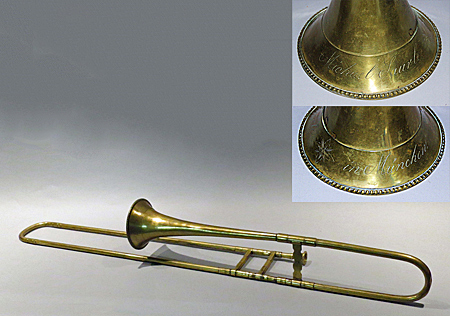
Owner: HWMC
Catalog#: CL-AELV-167
Trombones / Sackbuts
Trombone / Sackbut - Michael Saurle
Munich, Germany
Michael Saurle
Metal
ca. 1796-1830
Length: 38 in
Wind Instruments – Brass Instruments – Trombones / Sackbuts
Engraving (on the bell garland): Michael Saurle / (4 pointed flower/star logo) / in Munchen
This is a Michael Saurle (1772-1845) sackbut or primitive trombone of the late 1700s or early 1800s. Saurle was a musical instrument maker active in Munich, Germany, between circa 1796 and 1845. This instrument is in nice original condition with original mouthpiece. From paintings of the late 15th century, we find the earliest representations that show the trombone developed from a large trumpet through the addition of a slide. The German term “Posaune” points to another line of descent, the large and straight “buisine,” a name that goes back to “buccina,” an ancient Roman brass instrument. The name reappears in the medieval term “buysine” and in French, the name was “buccin” (or “buccine”).
During the late 18th century and early 19th century, the French “buccin” was a trombone with a dragon shaped head for the bell (also found in this collection). It was particularly popular for festival occasions during the French Revolution. The medieval name for the trombone was “sackbut.” It derived this name from the old Spanish word “sacabuche, “meaning to “draw tube,” or from the old French word, “sacqueboute,” meaning to “pull-push.” Throughout the 16th century the sackbut or primitive trombones were commonly used in the ceremonial bands of the nobility and cities, as well as in churches. The main differences between the sackbut or primitive trombone and its modern counterpart are that the sackbut had a narrower bore, a smaller bell and no spit key. Nevertheless, this instrument has always been called trombone in Italy and Posaune in Germany.
References: “Sackbut,” Keith McGowan/R, “The Groves Dictionary of Musical Instruments.” 2nd ed. Vol. 4., Laurence Libin, Editor in Chief. Oxford University Press.
